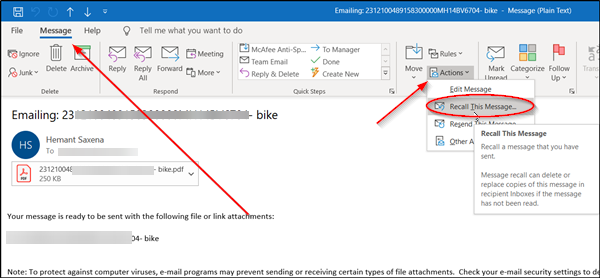Individuals working in an organization, having an Office 365 or Microsoft Exchange email account can configure Outlook to recall and replace a message. The reasons for exercising this option can be many and range from an embarrassing typo to anger, only to be regretted later. Whatever the case is, you can undo the ‘Send’ option in Outlook 2019/2016/2013/2010. Here’s how to recall an email.
Recall and replace an email in Outlook
Many times, when we review a message after it has been sent to someone, we realize there’s some mistake in it. Either an attachment was not loaded, or some important detail was missing. This makes us think, there should be a way to recall the sent messages. Fortunately, Microsoft’s popular email client – Outlook offers an option to recall and replace a message. To recall and replace an email in Outlook, you’ll need to do the following: Please note that this facility is not present in Outlook for the web. Also, if you don’t see the Recall This Message command after you click ‘Send’ button, you probably don’t have an Exchange account.
1] Recall and replace a message
Open your Microsoft Outlook account and from the left side-bar menu, select ‘Sent items’ folder. Then, go to ‘Move’ section. Under it, find ‘Actions’ menu.
Hit the drop-down arrow adjacent to ‘Actions’ menu and select any one of the following options from the list displayed,
Recall this messageResend this message
Instantly, a window will popup on your computer screen, prompting you to take one of the following actions,
Delete unread copies of this messageDelete unread copies and replace with a new message
If you would like to send a replacement message, compose the message, and then click ‘Send’ or select the desired option and hit the ‘OK’ button. Now, the success or failure of a message recall depends on settings configured in the recipient’s Outlook account. Below are the possible scenarios.
2] Different scenarios of Recall message for the sender and the recipient
The recipient is informed that you, the sender, deleted the message from his or her mailbox. Out of the two, if the recipient opens the recall message first, the original message is deleted. In such a case, the recipient is informed about the sender’s action (message deleted from the recipient’s mailbox). If the recipient opens the original message first, the recall action fails, and both the original and recall messages are available. If the recipient opens the original message first, the recall fails, and both the old and new messages are available for viewing. In such a case, only the new message remains and the sender receives a notification saying the recall attempt was successful. If the recipient has already marked the original message as read, he or she is informed that the recall failed, and only the recall message is deleted It is also important to mention here that the sender cannot choose to recall a message that’s protected by Azure Information Protection. It is also important to bear in mind that the success or failure of a message recall depends on the recipients’ settings in Outlook. Consider the following scenario to understand this concept better. Suppose you want to send a message to someone you know but find that the message is incomplete or missing something important. What do you do? Simple, recall the original message and replace it with a new one. Under such a scenario, both the original message and the recall message are pushed to the recipient’s Inbox and if ‘Automatically process requests and responses to meeting requests and polls’ checkbox under ‘Tracking’ option is selected by the recipient then, the original message is deleted and the recipient is informed that the sender has deleted the message from his or her mailbox. Similarly, if the same checkbox has no checkmark against it, then one of the following things can occur on the recipient’s computer, Message Recall is available after you click Send and is available only if the recipient has an Exchange account within the same organization. Read next: How to automatically Forward Email in Microsoft Outlook.



